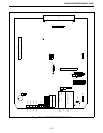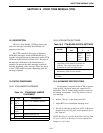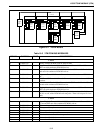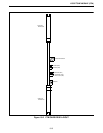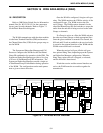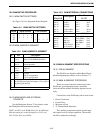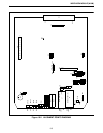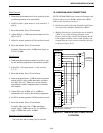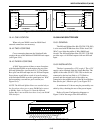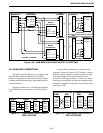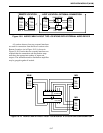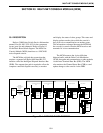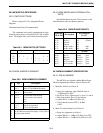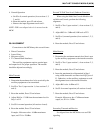
WIDE AREA MODULE (WAM)
19-4
Main Transmit
1. Determine the maximum level to be received by the
ancillary equipment to be transmitted.
2. Set S5 for Test 1 (open section 1, close sections 2, 3
and 4).
3. Reset the module, Press S2 and release.
4. Adjust R44 for -12 dB from the maximum level in
Step 1 at J12.
5. Select for normal operation (S5 all sections closed).
6. Reset the module, Press S2 and release.
Example: Microwave has -16 dBm max input, set
J12 for -28 dBm.
Main Receive
1. Determine the maximum transmit level that is sent
by the ancillary equipment to the interface module.
2. Select Test 1 (S5 open section 1, close sections
2, 3, 4).
3. Reset the module, Press S2 and release.
4. Insert an alignment tone -12 dB from the level deter-
mined in Step 1 using a 600 ohm audio oscillator
into EQU port of J1. Otherwise, set the ancillary
equipment to send the alignment tone to the inter-
face module.
5. Adjust R41 to be -6 dBm at J11, +6 dBm if
maximum level is sent by the ancillary equipment.
6. Set S5 for normal operation (S5 all sections closed).
7. Reset the module, Press S2 and release.
Example: Microwave has +7 dBm maximum
output. Apply -5 dBm and set J11 for -6 dBm or
apply +7 dBm, then set for +6 dBm.
Secondary Transmit and Receive
Not used since the secondary line is not used.
19.4 WAM E&M-LEAD CONNECTIONS
NOTE: All WAM E&M Lead connection Examples and
Figures reflect only one WAM configuration (WAC)
and only one Switch per location.
• Duplication of the following Examples and Figures
are required for multiple, simultaneous WACs.
• Multiple Switches per location that are included in
a WAC in any of the following Examples and
Figures need to daisy-chain E-Lead inputs and M-
Lead outputs and then connect them together. (An
example that has one Location with three Switches
is shown in Figure 19-3.)
Figure 19-3 WAM E&M LEAD CABLE LAYOUT
1 LOCATION
MA
MB
EA
EB
TXS+ (MA2)
TXS- (MB2)
WAM/SWITCH 1
MA
MB
EA
EB
TXS+ (MA2)
TXS- (MB2)
WAM/SWITCH 2
MA
MB
EA
EB
TXS+ (MA2)
TXS- (MB2)
WAM/SWITCH 3
MA
MB
EA
EB
EXTERNAL
CONNECTIONS
(SEE NOTE)
NOTE: EXTERNAL CONNECTIONS ARE THE INTERFACE TO
ANY ADDITIONAL LOCATIONS.



